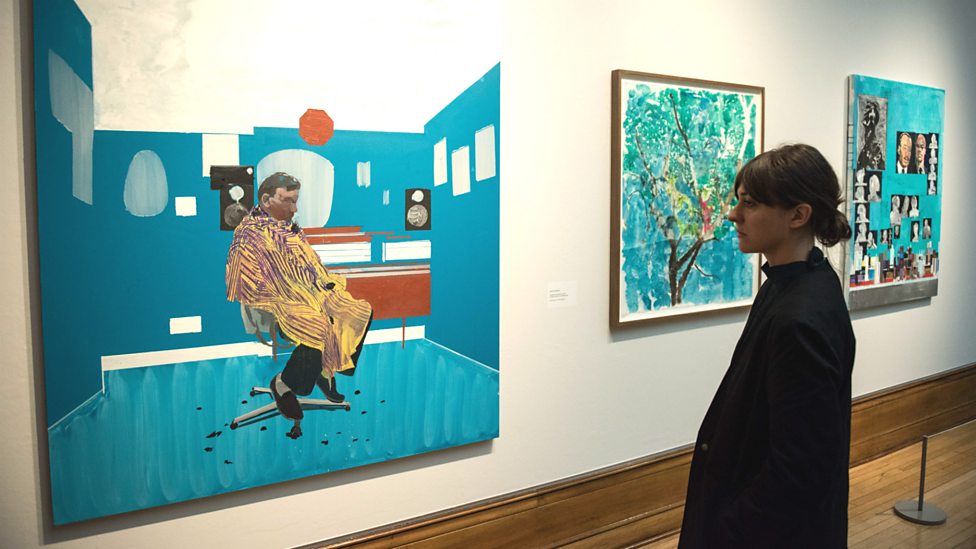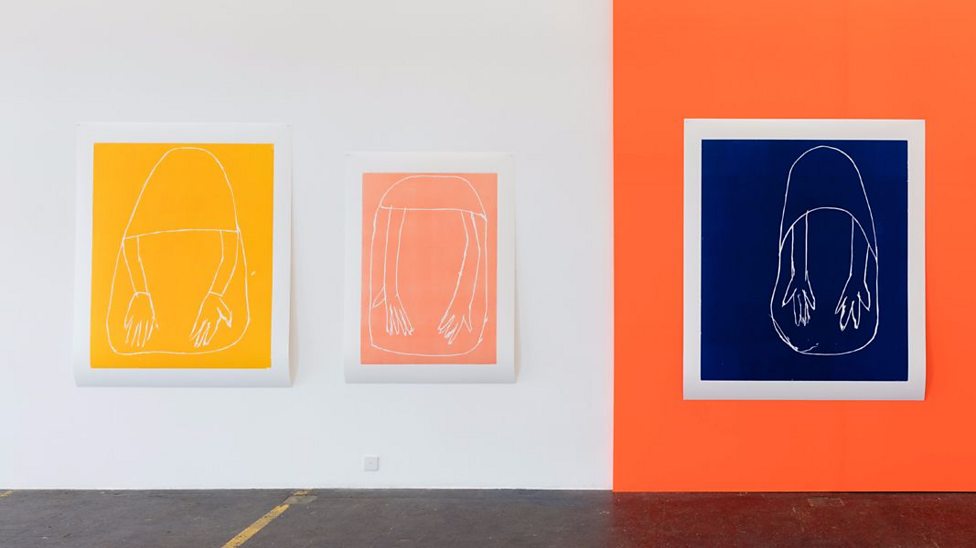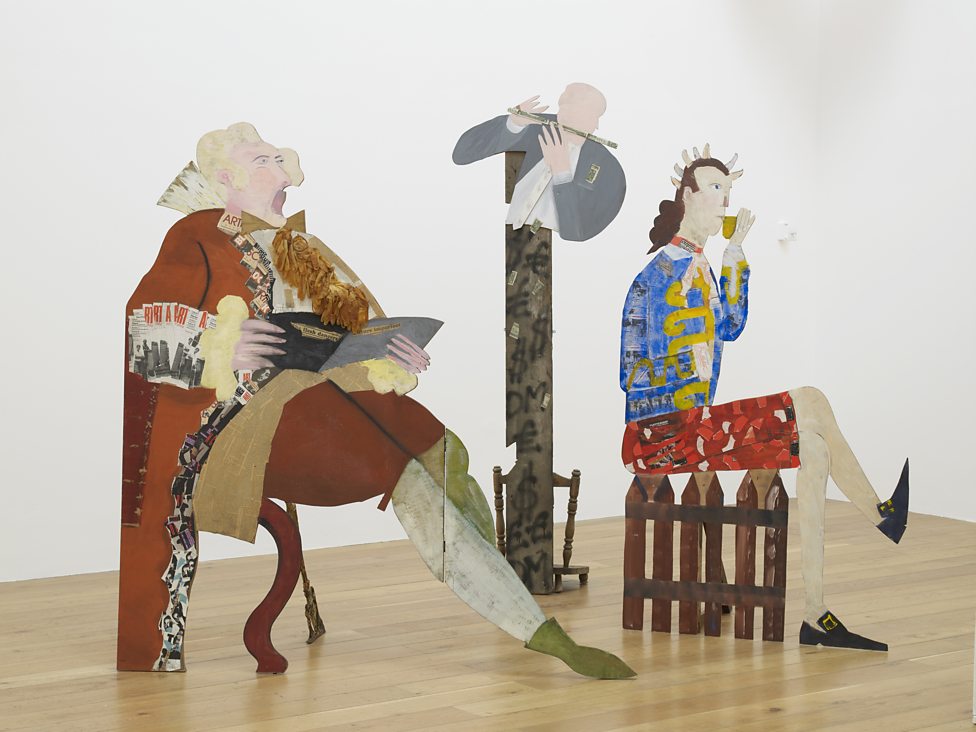Love it or hate it, the Turner Prize is one of the highlights of the
arts calendar, and this year it takes place in the UK City of Culture,
Hull. Ahead of the unveiling of the winner next week at the Ferens
Gallery, WILLIAM COOK tells us why Hull is the perfect place to host the
famously divisive awards. Artworks by Hurvin Anderson, including Peter's Sitters III (left), on
display at the Ferens Art Gallery, Hull. Photo: Oli Scarff/AFP/Getty
Images
Artworks by Hurvin Anderson, including Peter's Sitters III (left), on
display at the Ferens Art Gallery, Hull. Photo: Oli Scarff/AFP/Getty
Images
The
Turner Prize has always been a magnet for controversy. In 1998, a
protestor dumped a heap of manure outside Tate Britain, in response to
Chris Ofili’s use of elephant dung in his paintings.From Howard Hodgkin to Damien Hirst, from Antony Gormley to Grayson Perry, it’s like a Who’s Who of British Artists. So why does it ruffle so many feathers?
In 2002, Labour Culture Minister Kim Howells denounced the shortlist show as "conceptual bullshit" and Prince Charles bemoaned "the dreaded Turner Prize [which] has contaminated the art establishment for too long".
Is Prince Charles right? Has the Turner Prize really contaminated the art establishment? Of course not. It’s actually a fairly accurate reflection of current trends in contemporary art – a mirror rather than a motor.
The award usually goes to a rising star who’s already on their way up. If you don’t like their work, fair enough - but it’s daft to blame the Turner Prize.
A survey of previous winners bears this out. From Howard Hodgkin to Damien Hirst, from Antony Gormley to Grayson Perry, it’s like a Who's Who of British Artists. So why does it ruffle so many feathers?
Because giving prizes to artists is an invidious business, and because lots of people feel bewildered by an awful lot of modern art. That’s entirely understandable (I’m confused by a lot of it myself) but even if you’re not a big fan of this kind of thing, the Turner Prize is still fascinating.
It’s a snapshot of what’s happening in the art world - and if this year’s shortlist is anything to go by, it shows artists are making a welcome return to traditional forms.
Rosalind Nashashibi is a film-maker (a genre I’m not mad about in galleries) but her work is contemplative, not controversial. Even if you’re an old fuddy-duddy (like me) you’ll find lots in here to like.

Installation view of Andrea Büttner: Gesamtzusammenhang, Switzerland, 2017. Photo: Kunst Halle Sankt Gallen, Gunnar Meier.
The Ferens is a beautiful building with a fine permanent collection, and the Turner is a super showcase for its artworks from earlier centuries.
The Ferens is a beautiful building with a fine permanent collection, and the Turner is a super showcase for its artworks from earlier centuries
The gallery has had a £5 million facelift, and the Turner Prize has put it on the map. "There’s such a desire for this exhibition, such interest and excitement - which actually isn’t the case in London," says Sacha Craddock, co-curator of this year’s show.
The Ferens Art Gallery isn’t the only attraction here in Hull. The Maritime Museum commemorates Hull’s long history as a seafaring city, and the historic port has been revived as a nascent artistic quarter.
Humber Street Gallery hosts a range of provocative modern art shows. It’s also become a lively rendezvous – a great place to meet up and hang out.
My favourite show is New Eyes Each Year at Hull University. Philip Larkin spent three decades here as librarian in the Brynmor Jones Library, and now his old library has mounted an evocative exhibition in his honour.
Between racks and racks of books are scattered fragments of his sublime poetry, plus LPs, letters, bric-a-brac - the flotsam of a lifetime. It’s intensely atmospheric, and far more revealing than a more conventional display.
Back at Hull Station, waiting for my homebound train, I see they’ve put up a statue of Larkin in the forecourt – not bad at all, though I’m sure he would have hated it.
Inscribed around the base is a line from his poem Bridge For The Living, written to mark the opening of the Humber Bridge in 1972: "Reaching the world as our lives do, as all lives do, reaching that we may give the best of what we are and hold as true."
A good motto for Hull’s year as City of Culture, and its custodianship of this year’s Turner Prize.
A version of this article was originally published on 26 September 2017.
 Lubaina Himid - A Fashionable Marriage, 1986. Installation view of The
Place Is Here, © Nottingham Contemporary 2017. Courtesy the artist and
Hollybush Gardens. Photo: Andy Keate.
Lubaina Himid - A Fashionable Marriage, 1986. Installation view of The
Place Is Here, © Nottingham Contemporary 2017. Courtesy the artist and
Hollybush Gardens. Photo: Andy Keate. 












No comments:
Post a Comment